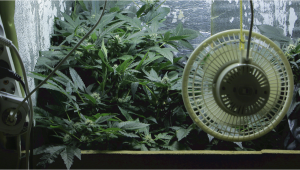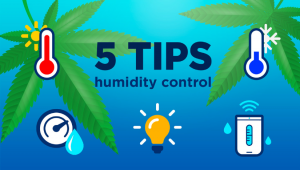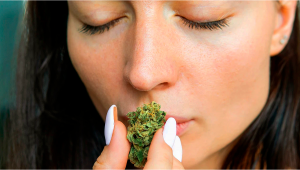Comprehensive Guide to Grow Tent and Grow Room Ventilation: Cost-effective and DIY Solutions

- 1. Introduction
- 2. Components of an effective ventilation system
- 2. a. Fan speed controllers
- 2. b. Thermostats and hygrostats
- 2. c. Monitoring equipment
- 2. d. Air exchange rate
- 2. e. Fan capacity and sizing
- 2. f. Filter and ducting considerations
- 2. g. Adjustments for environmental factors
- 3. Ventilation system installation and configuration
- 3. a. Grow tent ventilation setup
- 3. b. Adjusting for environmental factors
- 3. c. Maintaining negative pressure
- 4. Tips for optimizing ventilation
- 4. a. Sealing your grow space
- 4. b. Minimizing ducting length and bends
- 4. c. Proper fan and filter maintenance
- 4. d. Monitoring and adjusting temperature and humidity
- 5. Common ventilation issues and troubleshooting
- 5. a. Insufficient air exchange
- 5. b. Temperature and humidity imbalances
- 5. c. Odors escaping from grow space
- 6. Additional ventilation tips
- 6. a. Using co2 supplementation
- 6. b. Using air purifiers
- 6. c. Noise reduction
- 7. Maintaining ventilation equipment
- 7. a. Cleaning fans
- 7. b. Checking and replacing filters
- 7. c. Inspecting ducting
- 8. Optimizing grow space layout for ventilation
- 8. a. Plant spacing
- 8. b. Light placement
- 8. c. Ventilation equipment placement
- 9. Troubleshooting ventilation issues
- 9. a. High temperature
- 9. b. High humidity
- 9. c. Low humidity
- 9. d. Odor issues
- 10. Conclusion
Introduction
Achieving optimal results in indoor plants cultivation relies on creating and maintaining an ideal growing environment. One of the critical factors in ensuring a healthy and productive grow space is proper ventilation. In this comprehensive guide, we will explore the importance of ventilation, the components of an effective ventilation system, and cost-effective and DIY solutions for grow tents and grow rooms. We will also cover tips for optimizing your ventilation system, common issues and troubleshooting, and best practices for installation and configuration which aid you in making the most out of your plants seeds.
Components of an Effective Ventilation System
Fan Speed Controllers
Fan speed controllers allow you to adjust the speed of your exhaust and intake fans, providing precise control over airflow rates and enabling you to maintain optimal temperature and humidity levels in your grow space. Some fan speed controllers also feature built-in thermostats or hygrostats that can automatically adjust fan speeds based on temperature or humidity measurements.

Thermostats and Hygrostats
Thermostats and hygrostats are used to monitor temperature and humidity levels in your grow space, respectively. By integrating these devices with your controllers, you can automate fan speeds and other environmental variables, ensuring consistent growing conditions throughout your plants plants' life cycle.
Monitoring Equipment
Regularly monitoring your grow space's temperature and humidity is essential for maintaining optimal growing conditions and identifying potential issues. Invest in reliable monitoring equipment, such as digital thermometers and hygrometers to accurately measure and track environmental conditions in your grow space.
Air Exchange Rate
To determine the appropriate air exchange rate for your grow space, consider the size of your grow area, the number of plants, the type of lighting used, and the local climate. In general, a complete air exchange every one to three minutes is recommended for most grow spaces. However, you may need to adjust this rate based on the specific conditions of your grow space and the needs of your plants plants.
Fan Capacity and Sizing
Once you have determined the desired air exchange rate for your grow space, you can calculate the required fan capacity in cubic feet per minute (CFM) by multiplying the volume of your grow space (in cubic feet) by the air exchange rate (in minutes) (using the following formula:(L x W x H)/3 = CFM . This calculation will provide a starting point for selecting the appropriate exhaust and intake fans for your ventilation system.

Keep in mind that additional factors, such as ducting length, bends, filter resistance, and altitude, may impact fan performance and require adjustments to the calculated fan capacity. It is also important to note that the exhaust fan should typically be more powerful than the intake fan to maintain negative pressure within the grow space, promoting efficient air exchange and odor control.
Filter and Ducting Considerations
When designing your ventilation system, it is essential to consider the impact of carbon filters and ducting on airflow efficiency. Carbon filters can restrict airflow and reduce fan performance, so be sure to select a filter with the appropriate capacity for your exhaust fan and replace the filter media as needed to maintain effective odor control.
Additionally, long ducting runs and sharp bends can further reduce airflow efficiency. Minimize ducting length and use gradual curves whenever possible to maintain optimal airflow and fan performance.
Adjustments for Environmental Factors
Environmental factors, such as seasonal temperature fluctuations, can impact the effectiveness of your ventilation system and may require adjustments to fan speeds or other ventilation components.
Monitor your grow space's temperature and humidity levels regularly and be prepared to make necessary adjustments to maintain optimal growing conditions.
Ventilation System Installation and Configuration
Proper installation and configuration of your ventilation system components are crucial to ensure optimal performance and maintain ideal growing conditions. Here, we provide general guidelines for setting up your grow tent or grow room ventilation system.
Grow Tent Ventilation Setup
When setting up ventilation in a grow tent, follow these steps:
- Install your exhaust fan near the top of the tent, either inside or outside, depending on the fan type and available space. This placement allows the fan to effectively remove warm, stale air from the tent.
- Attach a carbon filter to the exhaust fan using ducting and clamps or zip ties, if odor control is required.
- Install your intake fan near the bottom of the tent, either inside or outside, depending on the fan type and available space. This placement allows the fan to draw in cool, fresh air to replace the warm air removed by the exhaust fan.
- Set up oscillating fans inside the tent to promote air circulation and maintain an even temperature and humidity distribution throughout the grow space.
- Connect any fan speed controllers, thermostats, or hygrostats to your fans, and install monitoring equipment, such as thermometers and hygrometers, to track environmental conditions.
Adjusting for Environmental Factors
Monitor your grow space's temperature and humidity levels regularly and be prepared to make necessary adjustments to maintain optimal growing conditions. This may include increasing or decreasing fan speeds, adding or removing oscillating fans, or adjusting temperature and humidity setpoints on your temperature and humidity controller.
Maintaining Negative Pressure
Negative pressure is essential for promoting efficient air exchange and odor control in your grow space. To maintain negative pressure, ensure that your exhaust fan capacity is greater than your intake fan capacity, causing the air to be drawn out of the grow space faster than it is being replaced.
This creates a slight vacuum effect, preventing odors from escaping and ensuring fresh air is pulled in through intake vents or passive openings.
Tips for Optimizing Ventilation
Proper ventilation is vital for a successful plants grow, and optimizing your ventilation system can help you achieve the best results. Here are some tips for maximizing the efficiency and effectiveness of your ventilation system:
Sealing Your Grow Space
Sealing your grow space can help prevent air leaks and ensure proper airflow through your ventilation system. Use weatherstripping, foam insulation, or caulk to seal any gaps or openings in your grow tent or grow room. Remember, however, to leave openings for your exhaust and intake fans and allow for passive air exchange if needed.
Minimizing Ducting Length and Bends
Long ducting runs and sharp bends can reduce airflow efficiency and fan performance. To optimize your ventilation system, minimize the ducting length and use gradual curves whenever possible. This will help maintain optimal airflow and ensure effective air exchange in your grow space.
Proper Fan and Filter Maintenance
Regular maintenance of your fans and carbon filters is essential for maintaining optimal ventilation system performance. Clean your fans and replace worn or damaged components as needed to ensure proper function. Additionally, replace the filter media in your carbon filter according to the manufacturer's recommendations or when you notice a decrease in odor control effectiveness or when it’s dirty.

Monitoring and Adjusting Temperature and Humidity
Regularly monitoring and adjusting temperature and humidity levels in your grow space is critical for maintaining optimal growing conditions. Invest in reliable monitoring equipment, such as digital thermometers and hygrometers with a good-quality, accurate sensor probe, and make necessary adjustments to your ventilation system to keep temperature and humidity levels within the ideal range for your plants plants.
Common Ventilation Issues and Troubleshooting
Even with the best-designed ventilation system, issues can arise that require troubleshooting and resolution. Here are some common ventilation problems and suggested solutions:
Insufficient Air Exchange
If your grow space is experiencing insufficient air exchange, it may be due to inadequate fan capacity, long ducting runs, sharp bends in the ducting, or clogged filters. To resolve this issue:
- Check your fan capacities and ensure they are sufficient for your grow space size and desired air exchange rate.
- Minimize ducting length and use gradual curves instead of sharp bends to improve airflow efficiency.
- Clean or replace your carbon filter if it is clogged or dirty.
Temperature and Humidity Imbalances
Temperature and humidity imbalances in your grow space can result from improper ventilation system configuration, inadequate fan speeds, or environmental factors.

To address these imbalances:
- Ensure your ventilation system is properly configured, with exhaust fans near the top of the grow space and intake fans near the bottom.
- Adjust fan speeds using fan speed controllers, thermostats, or hygrostats to maintain optimal temperature and humidity levels.
- Monitor and adjust for seasonal temperature fluctuations or other environmental factors that may impact your grow space's climate.
Odors Escaping from Grow Space
If odors are escaping from your grow space, it may be due to insufficient negative pressure, an inadequate carbon filter, or air leaks in your grow space. To resolve this issue:
- Ensure your exhaust fan capacity is greater than your intake fan capacity to maintain negative pressure within the grow space.
- Check your carbon filter for clogs or dirty filter media and replace it as needed.
- Seal any gaps or openings in your grow tent or grow room using weatherstripping, foam insulation, or caulk to prevent air leaks.
Additional Ventilation Tips
To further enhance your ventilation system and improve your plants grow results, consider implementing these additional tips:
Using CO2 Supplementation
Carbon dioxide (CO2) supplementation can boost plants plant growth and returns by providing additional CO2 for photosynthesis. However, it's essential to balance CO2 supplementation with proper lighting to avoid suffocating your plants. This means that PPFD levels should be above 1000 - 1100 in order to safely implement CO2. To implement CO2 supplementation in your grow space:
- Use a CO2 generator or bottled CO2 to release additional CO2 into your grow space.
- Install a CO2 monitor to measure CO2 levels and maintain optimal concentrations (typically between 1,000 and 1,500 ppm).
- Adjust your ventilation system to balance CO2 supplementation with fresh air exchange, ensuring that the CO2 levels don't become too high and that the grow space remains well-ventilated.
Using Air Purifiers
Air purifiers can help improve the air quality in your grow space by removing dust, pollen, mold spores, and other airborne contaminants. This can benefit your plants plants by reducing the risk of pests and diseases, as well as improving overall plant health. To use air purifiers in your grow space:
- Select an air purifier with a HEPA filter, which is designed to capture small particles and contaminants effectively.
- Install the air purifier in your grow space, ideally near the intake fan or passive air intake, to filter incoming air.
- Regularly clean or replace the air purifier's filter according to the manufacturer's recommendations to maintain optimal performance.
Noise Reduction
Ventilation systems can generate noise from fans, ducting, and other components, which can be a concern for some growers. To reduce noise levels in your grow space:
- Choose quiet fans, such as those with brushless motors or noise-reducing designs, to minimize fan noise.
- Use insulated ducting, which can help dampen sound transmission through the ducting material.
- Install soundproofing materials, such as acoustic foam or mass-loaded vinyl, around your grow space to absorb and reduce noise levels.
By implementing these additional ventilation tips and best practices, you can further improve your plants grow results and create an even more optimal growing environment for your plants.
With all of these tips and strategies, you're now well-equipped to design, install, and optimize a ventilation system for your grow tent or grow room. By considering every aspect of ventilation, from fan selection and placement to DIY solutions and additional enhancements, you can ensure your plants plants receive the ideal environment to thrive and produce outstanding returns. Keep refining your ventilation practices and enjoy the fruits of your labor!
Maintaining Ventilation Equipment
Regular maintenance of your ventilation equipment is crucial for ensuring optimal performance and prolonging the life of your components. Here are some essential maintenance tips for keeping your ventilation system in top condition:
Cleaning Fans
Dust and debris can accumulate on fan blades and motors, reducing efficiency and potentially causing damage over time. To clean your fans:
- Turn off and unplug the fans before cleaning.
- Use a soft brush or cloth to gently remove dust and debris from fan blades, motor housings, and other components.
- If necessary, use a mild detergent and a damp cloth to clean stubborn dirt, but avoid getting any moisture on electrical components.
Checking and Replacing Filters
Regularly check and replace filters in your ventilation system to maintain optimal airflow and odor control. This includes both carbon filters and any pre-filters or dust filters in your intake and exhaust fans.
- Inspect filters for clogs, excessive dust buildup, or damage.
- Clean or replace filters as needed, following the manufacturer's recommendations for your specific filter type.
- Remember that carbon filters generally need replacement every 12-18 months, depending on usage and grow space conditions.

Inspecting Ducting
Regularly inspect your ducting for damage, leaks, or obstructions that could reduce airflow efficiency or allow odors to escape.
- Check for any holes, tears, or loose connections in your ducting.
- Repair or replace damaged ducting as needed.
- Ensure ducting runs are as straight and short as possible, with gradual curves instead of sharp bends to maximize airflow efficiency.
By regularly maintaining your ventilation equipment, you can ensure the longevity and effectiveness of your system, providing your plants plants with the ideal environment to grow and thrive. Invest time and effort into proper maintenance, and you'll be rewarded with healthier plants, better returns, and a more enjoyable plants cultivation experience.
Optimizing Grow Space Layout for Ventilation
An essential aspect of an efficient ventilation system is the layout of your grow space. By considering the placement of your plants, lights, and ventilation equipment, you can create an environment that promotes optimal air circulation and temperature distribution. Here are some tips for optimizing your grow space layout:
Plant Spacing
Proper plant spacing is crucial for ensuring adequate airflow around each plant, which can help prevent mold, mildew, and pest issues. Additionally, proper spacing allows each plant to receive sufficient light without overcrowding. To optimize plant spacing:
- Determine the optimal number of plants for your grow space based on the size of your containers, the size of your plants at maturity, and your desired return.
- Space your plants evenly throughout your grow area to promote air circulation and reduce the risk of disease.
- Consider using trellising or training techniques, such as SCROG (Screen of Green) or LST (Low-Stress Training), to optimize airflow, and light distribution and penetration.
Light Placement
The placement of your grow lights has a significant impact on the temperature and humidity distribution within your grow space. To optimize light placement:
- Choose energy-efficient lighting options, such as LED or CMH lights, which produce less heat than traditional HID lights, reducing the burden on your ventilation system.
- Position your lights so that they provide even light distribution across your canopy while minimizing hotspots and shaded areas.
- Adjust the height of your lights as your plants grow to maintain the optimal distance between the light source and the plant canopy, reducing the risk of heat stress or light burn.

Ventilation Equipment Placement
The positioning of your fans, ducting, and other ventilation components can significantly impact the efficiency of your ventilation system. To optimize ventilation equipment placement:
- Position your intake and exhaust fans or vents diagonally across from each other, with the intake vent at the lowest point in your grow space and the exhaust vent at the highest point. This arrangement promotes effective air circulation and removes hot air, which naturally rises, from the grow space.
- Place oscillating fans strategically throughout your grow space to create a gentle breeze that reaches all plants, promoting transpiration and reducing the risk of pests and diseases.
- Ensure that your ducting runs are as straight and short as possible, with minimal bends, to maximize airflow efficiency and reduce the load on your fans.
By optimizing your grow space layout, you can create an environment that promotes efficient air circulation, temperature distribution, and light penetration, all of which contribute to a healthier and more productive plants grow. Pay attention to the details of your grow space design, and your plants will reward you with robust growth and bountiful returns.
Troubleshooting Ventilation Issues
Despite careful planning and execution, you may still encounter ventilation issues in your grow space. By identifying and addressing these problems early, you can minimize their impact on your plants and maintain a healthy growing environment. Here are some common ventilation issues and their solutions:
High Temperature
If your grow space is consistently too warm, consider the following solutions:
- Increase the power or number of exhaust fans to improve air exchange and remove hot air more effectively.
- Adjust your lighting schedule to operate during cooler hours of the day or night.
- Consider upgrading to more energy-efficient lighting options, such as LED or CMH lights, which produce less heat.
- Add air conditioning or evaporative cooling systems to your grow space to help maintain optimal temperatures.
High Humidity
If your grow space experiences consistently high humidity levels, consider these solutions:
- Increase exhaust fan power or add additional fans to improve air exchange and remove excess moisture.
- Add a dehumidifier to your grow space to help control humidity levels.
- Ensure your plants are adequately spaced to promote air circulation and reduce humidity buildup around leaves.
- Adjust your watering schedule to prevent overwatering, which can contribute to high humidity.

Low Humidity
If your grow space consistently experiences low humidity levels, consider the following solutions:
- Add a humidifier to your grow space to help maintain optimal humidity levels.
- Adjust your exhaust fan speed or run time to reduce the amount of moisture being removed from your grow space.
- Use a hygrostat to automatically control your exhaust fan and maintain a consistent humidity level.
- Place trays of water in your grow space or use a wet towel to increase humidity levels.
Odor Issues
If you're experiencing odor issues in or around your grow space, consider these solutions:
- Ensure your carbon filter is functioning properly and replace it if necessary.
- Inspect your ducting for leaks or damage, and repair or replace it as needed.
- Consider adding an additional carbon filter or an ozone generator to your ventilation system for added odor control.
- Ensure your grow space is adequately sealed to prevent odor leakage.
Frequently Asked Questions
Here are some frequently asked questions about ventilation in grow tents and grow rooms, along with their answers:
How do I determine the right fan size for my grow space?
To determine the right fan size for your grow space, first, calculate the volume of your grow space (length x width x height) and then determine the desired air exchange rate (usually around 1-3 air exchanges per minute for plants grows). Multiply the grow space volume by the desired air exchange rate to find the required fan capacity in cubic feet per minute (CFM).
Example:
- Grow space dimensions: 10 ft x 10 ft x 8 ft
- Volume: 10 x 10 x 8 = 800 cubic feet
- Desired air exchange rate: 2 air exchanges per minute
- Required fan capacity: 800 x 2 = 1,600 CFM
Can I vent my grow space directly outside?
Yes, you can vent your grow space directly outside, provided you consider factors such as local climate, potential odor issues, and security concerns. If venting directly outside, ensure you're using a carbon filter to minimize odors and comply with any local regulations regarding plants cultivation.
How often should I replace my carbon filter?
The lifespan of a carbon filter depends on factors such as usage, grow space conditions, and the filter's quality. Generally, carbon filters should be replaced every 12-18 months, but it's essential to monitor the filter's performance and replace it when you notice a decrease in odor control effectiveness.
Do I need an intake fan if I have passive air intake?
An intake fan is not always necessary if you have passive air intake, provided your exhaust fan is powerful enough to maintain negative pressure and ensure adequate air exchange. However, an intake fan can be beneficial in larger grow spaces or in situations where passive air intake is insufficient for maintaining optimal environmental conditions.
What is the best way to control temperature and humidity in my grow space?
The best way to control temperature and humidity in your grow space is through a combination of proper ventilation, air conditioning or heating (if necessary), and humidity control devices (such as humidifiers or dehumidifiers). Regularly monitor temperature and humidity levels using digital thermometers and hygrometers, and adjust your equipment as needed to maintain optimal growing conditions.
Conclusion
Proper ventilation is essential for creating and maintaining an optimal growing environment for your plants plants. By understanding the components of an effective ventilation system and implementing cost-effective and DIY solutions, you can achieve better returns and healthier plants while minimizing odors and maintaining a controlled climate.
This comprehensive guide has provided you with all the necessary information to design, install, and optimize a ventilation system for your grow tent or grow room. By following these recommendations and best practices, you can ensure your plants plants thrive and produce the best possible return. Now that you have the knowledge and tools to create an effective ventilation system for your grow space, you're well on your way to becoming a successful plants grower. Good luck and happy growing!








Comments